
A cardinal is a senior member of the clergy of the Catholic Church. Cardinals are created by the pope and typically hold the title for life. Collectively, they constitute the College of Cardinals.

The First Ecumenical Council of the Vatican, commonly known as the First Vatican Council or Vatican I was convoked by Pope Pius IX on 29 June 1868, after a period of planning and preparation that began on 6 December 1864. This, the twentieth ecumenical council of the Catholic Church, held three centuries after the Council of Trent, opened on 8 December 1869 and adjourned on 20 October 1870 after the revolutionary Capture of Rome. Unlike the five earlier general councils held in Rome, which met in the Lateran Basilica and are known as Lateran councils, it met in Saint Peter's Basilica in the Vatican, hence its name. Its best-known decision is its definition of papal infallibility.

Pope Benedict XIV, born Prospero Lorenzo Lambertini, was head of the Catholic Church and ruler of the Papal States from 17 August 1740 to his death in 1758.
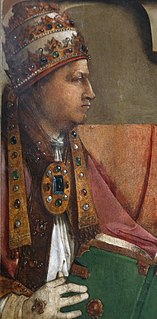
Pope Pius II, born Enea Silvio Bartolomeo Piccolomini, was head of the Catholic Church and ruler of the Papal States from 19 August 1458 to his death. He was born at Corsignano in the Sienese territory of a noble but impoverished family.

Pope Pius IV, born Giovanni Angelo Medici, was head of the Catholic Church and ruler of the Papal States from 25 December 1559 to his death in 1565. Born in Milan, his family considered itself a branch of the House of Medici and used the same coat of arms. Although modern historians have found no proof of this connection, the Medici of Florence recognized the claims of the Medici of Milan in the early 16th century.
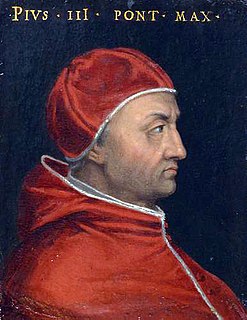
Pope Pius III, born Francesco Todeschini, was head of the Catholic Church and ruler of the Papal States from 22 September 1503 to his death. At just twenty-six days, he had one of the shortest pontificates in papal history.

Pope Pius V, born Antonio Ghislieri, was head of the Catholic Church and ruler of the Papal States from 8 January 1566 to his death in 1572. He is venerated as a saint of the Catholic Church. He is chiefly notable for his role in the Council of Trent, the Counter-Reformation, and the standardization of the Roman Rite within the Latin Church. Pius V declared Thomas Aquinas a Doctor of the Church.

Pope Pius VI was head of the Catholic Church and ruler of the Papal States from 15 February 1775 to his death in 1799.

Pope Paul II, born Pietro Barbo, was head of the Catholic Church and ruler of the Papal States from 30 August 1464 to his death in 1471. When his maternal uncle Eugene IV became pope, Barbo switched from training to be a merchant to religious studies. His rise in the Church was relatively rapid. Elected pope in 1464, Paul amassed a great collection of art and antiquities.
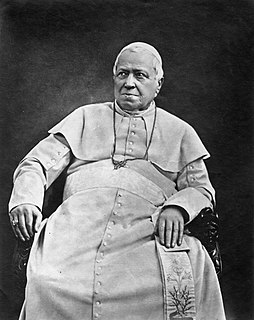
Pope Pius IX was head of the Catholic Church from 1846 to 1878, the longest verified papal reign. He was notable for convoking the First Vatican Council in 1868 and for permanently losing control of the Papal States in 1870 to the Kingdom of Italy. Thereafter he refused to leave Vatican City, declaring himself a "prisoner of the Vatican".

Pope Pius X was head of the Catholic Church from 4 August 1903 to his death in 1914. Pius X is known for vigorously opposing modernist interpretations of Catholic doctrine, promoting liturgical reforms and scholastic theology. He initiated the preparation of the 1917 Code of Canon Law, the first comprehensive and systemic work of its kind. He is venerated as a saint in the Catholic Church and is the namesake of the traditionalist Catholic Priestly Fraternity of Saint Pius X.
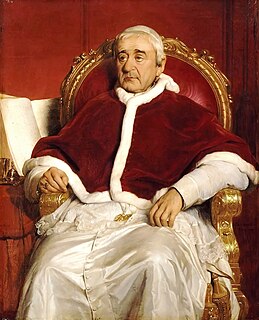
Pope Gregory XVI was head of the Catholic Church and ruler of the Papal States from 2 February 1831 to his death in 1846. He had adopted the name Mauro upon entering the religious order of the Camaldolese.
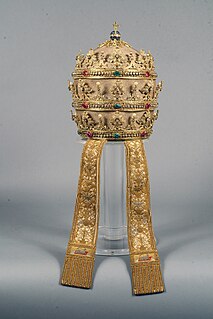
The temporal powerof the Holy See designates the political and secular influence of the Holy See, the leading of a state by the pope of the Catholic Church, as distinguished from its spiritual and pastoral activity.

The First Council of Lyon was the thirteenth ecumenical council, as numbered by the Catholic Church, taking place in 1245.

Giacomo Antonelli was an Italian cardinal deacon. He was the Cardinal Secretary of State from 1848 until his death; he played a key role in Italian politics, resisting the unification of Italy and affecting Roman Catholic interests in European affairs. He was often called the "Italian Richelieu" and the "Red Pope."

Pietro Gasparri, GCTE was a Roman Catholic cardinal, diplomat and politician in the Roman Curia and the signatory of the Lateran Pacts. He served also as Cardinal Secretary of State under Popes Benedict XV and Pope Pius XI.

Ercole Consalvi was a deacon and cardinal of the Catholic Church, who served twice as Cardinal Secretary of State for the Papal States and who played a crucial role in the post-Napoleonic reassertion of the legitimist principle of the divine right of kings, of which he was a constant supporter.

The Colloquy at Poissy was a religious conference which took place in Poissy, France, in 1561. Its object was to effect a reconciliation between the Catholics and Protestants (Huguenots) of France.
The Secretariate of Briefs to Princes and of Latin Letters, or simply the Secretariate of Briefs, was one of the offices of the Roman Curia abrogated in 1967 during Pope Paul VI's reform of the Pontifical court. It was divided into two sections.

Pope Pius X created 50 cardinals in seven consistories. Twenty of them were Italians. He created 17 cardinals at four consistories over four years from 1903 to 1907 and then, after several postponements and allowing the membership of the College of Cardinals to fall to 47, created 19 cardinals in 1911, announcing 18 and reserving the name of one, the largest number of cardinals at a single consistory in a century.



















